In the last few years, I have reviewed more lenses than you could possibly imagine.
My photography students are always asking which lens is right for them, so I spend a significant amount of time looking for lenses that offer superior quality at lower price points.
These are the best inexpensive Canon lenses I could find.
There are many others that I'm sure people will mention in the comments, but only 6 could make the cut for this list.
These lenses are the ones that I recommend very often on the Improve Photography Lens Finder.
I spent thousands of dollars and over a year developing the lens finder.
It basically asks you 5 questions about what lens you want, and then recommends the perfect lens for your situation.
I must mention from the outset that I use “the triad” of lenses (explained later), so I'm comparing the lenses in this list against the highest quality lenses in the Canon system at any price.
In all instances I have found these lenses to perform extremely well with Canon L lenses, but for WAY less money.
This is the good stuff–even when compared to the highest quality lenses money can buy.
Also, I must issue a disclaimer that the word “inexpensive” means different things to different people.
I am using the word “inexpensive” to compare these lenses to the top performing Canon L lenses that are generally priced around $2,000.
Tamron 28-75mm f/2.8 Lens
About a year ago, I had the opportunity to spend some time with a rep from Tamron and spend the day shooting just about all of the lenses in the Tamron lineup.
To be honest, I was not thrilled with most of them.
Most were “acceptable” and one lens was jokingly awful.
I finally couldn't take it anymore and I asked the rep to show me just the one best lens in the Tamron lineup.
He reached for the Tamron 28-75mm f/2.8. Skeptically, I played with it and shot with it for a while.
I was blown away at the quality from this lens.
I found this lens to be extremely close to the sharpness of the $2,400 Canon 24-70mm, and it adds one really impressive feature that the Canon doesn't–it's also a nice macro lens.
For me as a professional photographer, I would definitely take a long hard look at the Tamron 28-75mm before shelling out MORE THAN FOUR TIMES the cost to buy the Canon 24-70.
You can check the current price of this lens on Amazon.
You can also check KEH Camera to see if you can save some money on a REALLY high quality used one.
KEH Camera also has REALLY good financing option!
Canon 70-200mm f/4
Before you get lost in your excitement over the price of this Canon lens, notice that the f/stop only goes down to f/4 instead of the much-desired f/2.8 version of this lens (which costs about $2,500 dollars!).
To have an f/4 maximum aperture is not entirely negative; in fact, it gives you a lighter lens than the f/2.8 version with nearly equal optical quality.
The fast aperture will give you great results all the way through the lens to the edge of the photo.
In fact, many professional photographers who have used the 70-200mm f/2.8 for years are now switching over to this f/4 version to save some money and to lighten their load.
If you haven't used professional lenses before, you may not appreciate just how heavy they are, so saving weight by choosing this f/4 lens is a significant benefit over the $2,500 f/2.8 version of this lens.
This is probably the most popular lens for photographers buying their first professional-grade “L” lens (Canon's marker for their professional quality lenses).
There are two 70-200mm f/4 lenses available for the Canon system. Both are “L” glass, but one has image stabilization and one doesn't.
The image stabilized version is significantly more expensive, but the optical quality is similar between the two versions.
Click here to check the price of the less expensive non-IS version on Amazon, or else you can click here for the much more expensive version with IS on Amazon
You can also check KEH Camera to see if you can save some money on a REALLY high quality used one:
Canon 85mm f/1.8 – $335
If I could pick only one prime lens for portrait photography, it would be the 85mm.
There is also an 85mm f/1.2 lens available for the Canon system, but this lens is nearly as good for much less money.
The 85mm focal range allows you to maintain a bit more distance between you and your client.
Also, the bokeh in your backgrounds just look silky smooth.
You will be amazed at the sustained image quality all the way to the edge of your photos, even with finer detail.
When shooting portraits with this 85mm lens, full-frame shooters will see a slight softness around the edges… but nothing you can’t live with.
Check the price of this lens on Amazon.
You can also check KEH Camera to see if you can save some money on a REALLY high quality used one.
Canon 100mm f/2
The Canon 100mm f/2 is the twin sister of the 85mm f/1.8 lens mentioned previously, but this one was born 15mm later.
In terms of build quality, value, and sharpness, these lenses are both about equal.
So now the question–which one do I pick?!?!? My rule is this: if you EVER shoot indoor sports, you want the 100mm f/2.
It's just about as fast and sometimes the extra 15mm can make a real difference for indoor sports.
This is a great option for indoor sports because it is ridiculously fast and is a good focal length for “close” sports where you can get right up to the sidelines like swimming, wrestling, tennis, some basketball games, etc.
Aside from indoor sports, this lens is fantastic for portraits as well. If you are shooting exclusively portraits, it is difficult to choose between the 85 and the 100.
The features on the face become flatter and more flatterING when shooting with a longer focal length, but photos shot with a slightly shorter focal length have a more intimate feel.
In general, I'd recommend the 100mm for full frame cameras (5D Mark III or 6D, for example) and the 85mm f/1.8 for crop sensor portraits (like the Canon Rebels, 70d, etc.)
Check current prices for the Canon 100mm f/2 on Amazon.
You can also check KEH Camera to see if you can save some money on a REALLY high quality used one.
Canon 100mm f/2.8 MACRO Lens
Things just got complicated. You decided between the 85mm f/1.8 and the 100mm f/2, but now there is a third option with a similar fast aperture and similar focal length.
This one, however, adds macro capabilities which means it can focus very close to the camera.
But this lens is not only for macro photography.
Given it's sharpness, fast aperture, and convenient focal length, it also makes a nice portrait lens.
This lens is the little brother of the Canon 100mm f/2.8 L lens, which is slightly sharper and has better build quality.
But just because there is a more expensive version of this lens does not take away from the value of this excellent and sharp portrait and macro lens.
If you want to do serious macro photography on a budget, then this lens is an excellent option.
If however, you really want to do serious portrait photography and it would just be handy to do macro as well, I'd advise you to pick the 100mm f/2 (mentioned above) and simply buy this close focus filter on Amazon to add on the lens when you want to occasionally do macro work.
Check the current price of the Canon 100mm macro on Amazon.
You can also check KEH Camera to see if you can save some money on a REALLY high quality used one.
Canon 50mm f/1.8 II
Every photographer should own a 50mm f/1.8 lens as your first upgrade from the kit lens that came with your camera.
This lens is significantly sharper than the kit lens, has an extremely fast aperture for blurry backgrounds and shooting in low light, and the price is unbelievably good.
This little guy will just simply astound you at the great quality and stunning images you will get.
At the low price, it’s nearly a no-brainer to add this lens to your lineup.
This lens maintains great quality all the way to the edge at lower f/stop values.
This is a prime lens, so you will have to physically move to zoom in and out and potentially get in your client’s face.
I used the “nifty fifty” (as photographers often call this lens) for several years before investing in uber-expensive pro lenses.
Looking back, this lens is only a tiny bit less sharp than pro lenses, but for me the real benefit of the more expensive lenses is the zoom.
Many photographers love shooting prime lenses such as this, but most of the time I prefer a zoom.
Check the current price of the Canon 50mm f/1.8 on Amazon.
You can also check KEH Camera to see if you can save some money on a REALLY high quality used one.
Two more lenses that ALMOST made the list
There are two more lenses that I was extremely tempted to put on this list but resisted because they are a bit too expensive to be called “inexpensive” even though they are much less than other lenses of similar quality.
They are the Canon 24-105mm f/4 lens and the Canon 200mm f/2.8L.
The Canon 24-105 is probably the best “walk around” lens in the Canon lens lineup.
It is used by many professional photographers as a street photography and “chase the kids” lens.
It has a reasonably fast aperture, a convenient focal length, and is sharp as a tack.
I just wish it came down in price a couple hundred bucks.
The Canon 200mm f/2.8 L is a marvel of engineering.
For the price, you get a sharp, fast prime lens that would be terrific for shooting indoor sports, longer portraits on a full frame camera, etc.
Highly recommended though if I were spending that much I'd have to figure out how to justify purchasing the 200mm f/2.8 instead of the 70-200mm f/4 for even less money.
One side note…
Just about every professional photographer I know owns the same three Canon lenses: The 16-35mm f/2.8, Canon 24-70mm f/2.8, and the Canon 70-200mm f/2.8.
Photographers often refer to these lenses as “The triad,” and the same lens names make up the Nikon triad.
I certainly wouldn't agree that you need these three Canon lenses to be a professional photographer.
But I do want to bring out the point that professionals rely on this triad because they are all nearly flawless, fast lenses that cover the entire range of focal length that most photographers need for general photography work.
I want to re-iterate that I do not think the triad of lenses is necessary for photographers to own in order to produce top notch photography.
That's the whole point of this article!
But if you plan to shoot your camera system for many years and you are in a position to invest heavily on lenses, one advantage to these lenses is they generally last a decade or longer with excellent results.
I know many photographers who purchased a 70-200mm seven years ago and who don't feel the need to upgrade to the newer versions because their original is still so good.
Quite frankly, the difference between most of the lenses on this list and the more expensive competitors to these lenses is extremely minor.
I wouldn't put too much stock in what the camera manufacturers want you to think you need to take a nice sharp photo.
Disclaimer: Improve Photography is a participant in the Amazon Services LLC Associates Program among other affiliate programs, an affiliate advertising program designed to provide a means for sites to earn advertising fees by advertising and linking to Amazon.com and other websites.

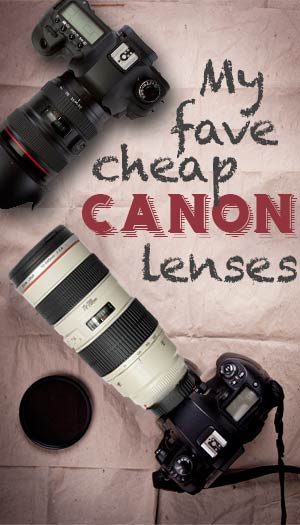





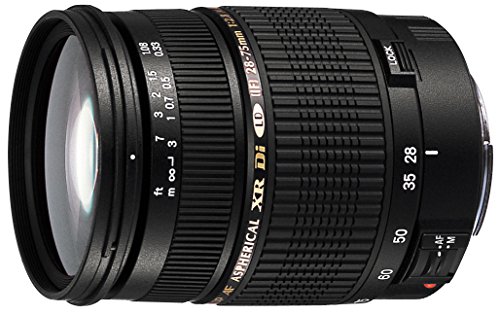
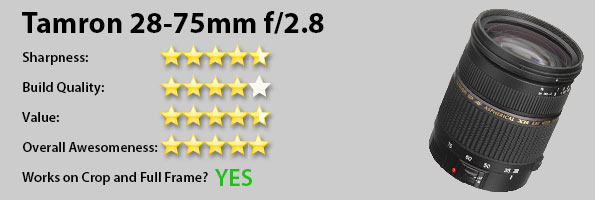
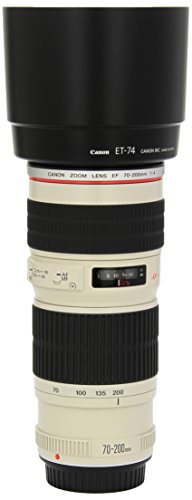
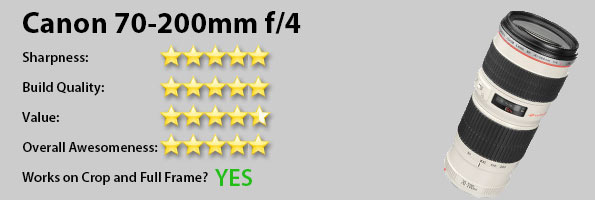

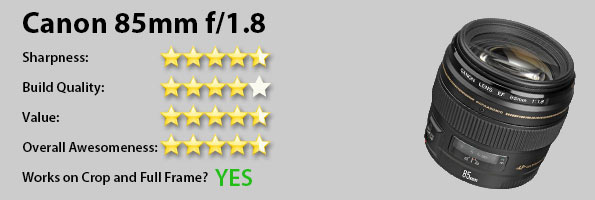

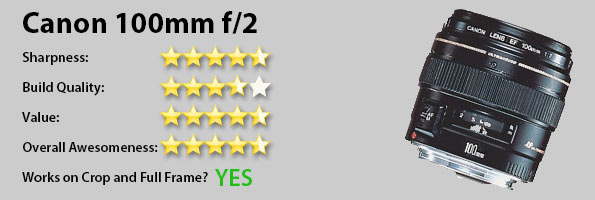

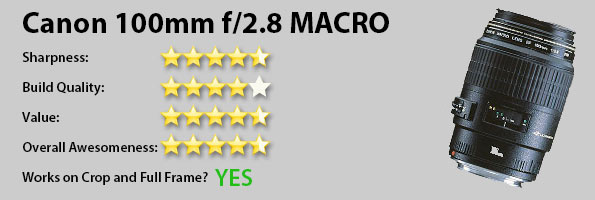


What do you recommend as a good 30mm lens for a full-frame sensor? I mostly do corporate video production so my requirement is for fairly controlled environment, mostly interviews. You can see my work at http://www.usmanzuberi.com It’s your standard corporate videos. Currently I am shooting on 7D but thinking about making a transition to BMPC 4k. Appreciate your feedback in advance.
I love reading all the different opinions and advice people have on this topic and hope someone might have some to offer myself. I’m still very (VERY) new to photography and am about to make a purchase of my first DSLR, which I’m leaning towards getting a Canon 5D Mark III. My shoots are primarily indoor newborns and families as well outdoor maternity shoots and I love capturing nature and landscapes. I’ve been recommended a couple of lenses that have been mentioned above and I’m wondering people’s thoughts on these- the 50mm 1.8 & the 24-105mm f4. Any feedback would be greatly appreciated!
@Jeff: I’m already doing most if the tips those lists give. I’m shooting on low ISO, quick shutter speed, full manual except focus, large aperture for shallow dof for portraits, manual focus point selection on closest eye. And often when I zoom in afterwards, the eyelashes are not sharp, but for example a piece of fabric of the subject’s sweater is.
It seems to play up more with low light (and thus higher ISO). I suspect my autofocus points are not well calibrated.
Have you tried the new Canon EF-S 10-18 IS STM? Built like a kit lens with plastic mount and all that low quality stuff, but image quality is GREAT and it’s probably the cheapest ultrawide around. Crop sensor only, of course.
Hi all, I’m currently shooting with a crop sensor Canon 70D and I finally feel at the stage where I want to begin on the more serious side of portrait photography (hoping to make a little $$$ on the side) and was wondering on your best suggestions for a good portrait lens that would be equally adequate for indoor as well as outdoor photography.
I currently own the a Canon kit lens (18-135mm) 3.5-5.6 as well as the CANON 50MM F/1.8 II mentioned above. While I think this may too “cramped” for an indoor shoot, what should I be looking for? I’m looking to get my photos sharper than the current ones i’ve been able to produce without blowing the budget…
Hi there, I’m also very new to photography. I bought my cousin’s 7D, but that was body only. To make a cheap start, I got myself a second hand Helios 44-2 (58 f/2)and a EF-S 24mm f2.8 STM lens. I like both lenses, for the limited use they have had so far, they are great. I like the Helios for portraits, and the other one for general stuff, and it’s quite versatile. I’d like, however, to do some sports photography, gymnastics and ballet. I’ll still have to learn an awful lot before my pictures can be halfway decent, but I’d like your advice on which lens to buy for this. It can’t be more than about 500€, as I’m still a student and have got loans to pay as well.
Sports photography is going to be a toughy since you may want to invest in a lens that has some reach. 70-200L? Little pricey for me right now as well. There may be some Sigma lenses or Tamron that fit the bill and are decent quality. You will want the longer focal lengths for making the background appear “closer” and have more of shallow depth of field.
The Canon EF 75-300 f/4-5.6 III could be one to look at or Canon EF 70-300mm f/4.0-5.6 IS USM. Not exactly 5 star quality but on a budget could work. There may be a few more, but I would have to do more searching.
Hi
You are very lucky to get to begin photography with such a great camera body. If your into sport photography the most important thing you want is a lens with image stabilization because people are obviously moving pretty quickly. I would recommend a 55-250mm for something like ballet and gymnastics because although it has a pretty good maximum zoom it also has a great focal ranch. They only cost about 200 dollars (don’t know what that is in euro’s) but they are pretty cheap.
You also want a tripod or mono pod even with image stabilization but they are pretty straightforward.
Have a Good one
Dear Sacha, sorry to bud in but I thought its important for you to know – image stabilizer is important for hand-held shooting, not when using tripod, because this feature doesn’t correct a picture of moving object or figure, it corrects blurriness that may cause by shaking camera. For telephoto lenses its more important feature. Even a very subtle shake becomes very magnified and causes noticeable blurriness on a telephoto lens.
Hope this helps.
I had a Canon 7D with the battery grip and the 24-105mm L f/4 and the 70-300mm f/4-5.6 lenses. I used the 70-300mm a lot for outdoor sports. It was acceptable, but not close to what the 70-200mm f/2.8 could produce. And the combination of the 7D and the 70-300mm failed horribly in a gym for basketball.
I have since sold all my Canon gear and made the switch to an Olympus OM-D E-M1 system. I have 3 fantastic lenses for it, the Olympus m.Zuiko 45mm f/1.8 prime (equivalent to a 90mm on a full-frame system), the Olympus m.Zuiko 75mm f/1.8 prime (equivalent to a 150mm on a full-frame system) and the Olympus m.Zuiko 12-40mm f/2.8 (equivalent to a 24-80mm on a full-frame system). I love this system. The lenses are incredibly sharp. The 75mm may be the sharpest lens I’ve ever used.
I’m currently renting their new m.Zuiko 40-150mm f/2.8 (equivalent to a 80-300mm full-frame) and shooting a lot of sports with it. Its plenty fast for daytime action. However, the system falls apart when shooting at night. The m4/3 sensor on the Olympus just can’t handle low light very well. But in daylight, it works well. 10fps and the 40-150mm is incredibly sharp.
I have the 85mm /f1.8. I use it for casual portrate shots at family gatherings and for indoor volleyball. The lens is fast enough in poorly lit gyms and the bokeh really helps to set the players off of the background. Stopping down a couple of f-stops will increase the depth-of-field to give a little latitude for the players’ movement. I have always used the kit zoom lens that came with the camera. I bought this lens because of the wide aperture but never thought that there would be that much improvement in image quality on the same camera body. After using this lens, my kit lens makes everything look so flat. I have also become accustomed to moving forward and back to adjust my framing. I rarely take this lens off of my camera.
I agree with many of those and have many myself.
I love my Nifty Fifty (50 mm f1.8)
The 85 mm f1.8 is a MUST have for portraits on the cheap
The 100mm f2.8 macro is great for flowers and bugs but also a GREAT portrait lens if you cant swing the 70-200 and can move your legs to zoom
Primes are the way to go if you don’t need the zooms
I use my 24-105 a lot.
Im debating on the 70-200 f4 instead of a 2.8 as its important for portraits and concert shots in low light and sports indoors
its a must. F4 wont cut it. if you only shoot outside then the f4 version is fine. Know what you will be using it for BEFORE buying any lens to avoid being upset or get buyers remorse for getting the wrong lens for your needs. The pros get sponsored a lot and get paid for jobs and can afford the f 2.8 lenses easier
I just got the 40mm pancake f2.8 for a light compact street photography lens for my 6D. Great so far
The holy trinity of the 16-35 and 24-70 and 70-200 is great but very expensive
If you have a crop sensor camera (1,6x for canon) then get a 10-22 mm. Excellent wide angle for architecture and landscapes (16-35 mm equivalent on full frame)
Also the sigma 17-50mm f2.8 is a great constant aperature for less money
What’s the best lenses to shoot shows in venues for beginners?
@Sean,
Not sure exactly what kind of shows you are talking about, but I am guessing that you are talking about some kind of thing where there are booths setup indoors? If that is right, you need a lens with a big aperture (small number) like f/1.8. If you are a Canon shooter I highly recommend the Canon 50mm f/1.8 II lens (a new STM version is just about to be released next week, but you can save a few $$ getting the older one). It offers great performance at a very reasonable price. Nikon offers a similar lens as well. You can check out my article about why I think a “Nifty Fifty” should be the second lens a beginner should buy here.
I love this article. I have been using my Rebel T3i for mostly bird photography. I’m wondering what would be a great lens but also easier on the budget? I am currently using the 55 – 250mm but at times it seems to not quite able to reach the bird I am trying to capture and have it “fill” the screen. Any pointers would be great!
Great review, thanks! I have the 50mm f1.8 but am considering the 40mm f2.8 stm as a lighter option. I shoot mostly outdoors, candid shots of my kids (not necessarily super active /fast). Would love your opinion on that lens. Thanks for the help!
I am looking to upgrade my lenses I have a 18-55mm that came with my kit as well as 55-250mm. I take pictures of my kids indoors and outdoors as well as sports indoors and out doors. My kids are little so I need something that is faster than what I have as well as better in low lighting situations. A great over all every day lens as well as telephoto lens. I am an amateur, but trying to learn more.
Thanks! I’ve added this page to my favourites. I am interested in the 85mm for portraits.
Hey!
I’ve started shooting ice hockey and only a beginner. I’m looking to get a faster lends and can’t decide on either the 70-200 f4 of canon of save a little more for the tamron 70-200 f2.8. I’m a student right now and only doing this as a hobby to learn more about photography. Also what inexpensive wide angle lens would you advice? Thanks for the help!
Canon 200mm f2.8. Why this and not the 70-200 f4? I own both but no longer use the zoom, not because of image quality, although I think the prime is sharper at equivalent apertures, but for the 2.8 aperture and size. And it’s not white, making it less conspicuous. No stabilisation, so I’ve got to keep the shutter speed up … like at least 1/640. But a top lens
I am on the look out for an awesome lens that takes super sharp photos, has quick accurate auto focus, has image stabilization, good focal length and still gives decent bokeh. I am not wanting to spend more than $1,000 but am willing to save if it means getting the right lens. I take primarily natural light family portraits but am also wanting to venture into indoor studio portraits as well as photographing births and doing some lifestyle photography. I currently own a Canon EOS 70D and have been using the 50mm 1.8 however, I hate not having the ability to zoom and so need something that is more versatile. I have been debating on the Tamron SP 24-70mm Di VC USD but is is $1,300 and some of the reviews on it have me worried. The Canon 24-105 f/4 you mentioned sounds great but with it I am wondering if it is the best fit for my needs. Maybe you know of the perfect lens for what I do? Any suggestions you can offer would be greatly appreciated. I am so ready to purchase a lens already and all these reviews and lens options have my head spinning! Thank you! 🙂
Very useful post indeed! I bought new Canon 6D so I have to buy couple of lenses. What lens would you suggest for architecture and street and what for fashio/editorial photography?
Thanks!
Your highlight lenses and details on them hit the target well. Excellent choices. However, I would challenge folks looking for lenses, especially if new or expanding their range, to consider some excellent lenses that are only available on the used marked.
Myself, I shoot a lot of auto racing on a regular basis. I am generally side by side with EOS 1Dx and big white lenses. That said I shot for the longest time with a Rebel T1i / T2i and a Canon 28-135 and a Tamron 18-200. I got really good shots. (I’m really good at sweeping with low shutter speeds, I might add…)
Other lenses, on the used market, I have found great for portrait and promo work without jumping past $100 for any of them.
The Canon 28-105 and 28-70 (3.5-4.5) deliver fine results. They are discontinued but carry great glass from the film days.
The USM Canon 70-210 3.5-4.5 is also an excellent budget sport lens without jumping into 4 figures. Used market they are $90-$140… There is also a constant f4 version but is older but reviews still talk about really good results.
The f3.5-4.5 lenses are out there in a number of ranges and carry near “L” quality glass without the bucks.
If you really want to be impressive, get the 50 1.8 mkI. It is the original with a metal mount, a distance scale and a manual focus ring. However, it generally goes for twice as much or more than the current mkII. The glass in the current is the same with excellent results as mentioned but the older has some useful features.
Currently, I shoot with a 5D mkII and a 70D but keep the T2i handy as well.
Look up and research some of these discontinued lenses in the f3.5-4.5 range. Shy away from the budget kits that are f4-5.6 or higher even though the prices look even more attractive. There is good budget glass out there especially if using APS-C cameras as you are catching the sweet spot leaving any real softness or distortion off the sensor.
They are not “L” glass, but they offer great results.
PS – LOTS of good info on your site. I would urge visitors to bookmark it for future reference.
Currently a T3i user, I am toying with the idea of upgrading to a 70d. I am wanting better photos of the grands at sporting events. I shoot from the stands usually using Canon 70-300. New lens or new camera? Oldest grand is a senior. I’m having a tough time with the low lights. I ramble between TV, AV, and Sports mode. Yes, I do get some good shots, but I get more with blurs.
Don’t worry about all the blurry ones – just shoot more and throw plenty away. Digital film costs almost nothing
Considering that both the t3i and 70d are crop sensor bodies, I would invest in better glass. It’s going to be more affordable at this point. Also, once you’re more satisfied with your ability to use your camera to capture sharper images, you can always sell your current t3i body and upgrade